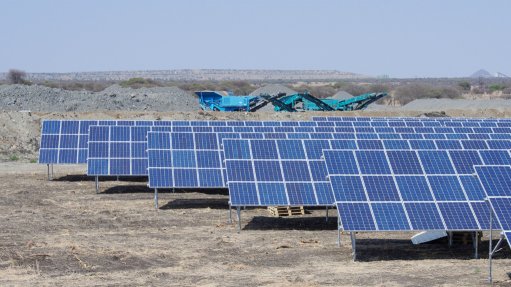
Photo by: Cronimet Mining
TORONTO (miningweekly.com) – Mining and energy solutions firm Cronimet Mining were recently selected to proceed to the next round of approval for independent power producers (IPPs) to bring six 5 MW South African projects on line.
Should Cronimet receive approval to bring 30 MW of production capacity on line, and combined with its 1 MW hybrid renewable energy solution already up and running at its chrome mine, in South Africa’s Limpopo province, it would represent a diversification of its business model, the company’s Power Solutions MD, Rollie Armstrong, told Mining Weekly Online during the recent Prospectors and Developers Association of Canada’s international convention, in Toronto.
“There was a huge shakeout of many companies that vied for the limited number of licences that would be awarded. Even larger firms that fell out in the large-capacity IPP programmes and then applied under the small renewable IPP programmes fell out, which really points to the robustness of our solutions," he said.
The company is also focused on bringing three 5 MW projects on line in Namibia.
Armstrong said that Southern African miners were increasingly becoming aware of the potential to generate their own electricity, and the potential to sell it to local authorities. Even more so than when compared with regions such as South America, where access to electricity is a significant concern.
“Southern Africa is an amazing market for us,” he said.
Cronimet Mining - Power Solutions, formerly Solea Capital and the parent company of South Africa-based Solea Renewables, is pioneering the combination of photovoltaic (PV) energy with diesel generation sets to create hybrid renewable energy solutions. It specialises in developing, financing, integration, construction and operating its hybrid power facilities and utility-scale renewable-energy infrastructure worldwide.
The company had built an initial phase of 1 MW off-grid solar PV plant that was integrated into the electricity supply system at its chrome mine, in Limpopo.
The mine, which forms part of a larger international enterprise that supplies and recycles stainless steel raw materials, introduced the PV facility in an effort to reduce its reliance on diesel generators.
Until the end of 2012, the operation had been fully reliant on the generators, which were installed when the Thabazimbi-based mine was unable to secure a connection from national power utility Eskom.
The 4 170-panel facility spans a two-hectare area and was installed between August and December 2012, by solar contractor Solea Renewables and Cronimet Energy South Africa. The panels were imported from Jinko Solar, of China.
The solution is expected to have a payback period of less than four years and should operate for a period of 25 years – the mine reportedly had sufficient reserves to sustain mining for several decades.
The hybrid power solution generates electricity from the solar PV systems, integrated with the minimal use of diesel generators during the day, and switches over to full diesel generation for night operations.
Armstrong said that the plant produced about 1.8 GWh and is expected to displace 450 000 l/y of diesel fuel.
He explained that the diesel generators’ technical application was perfectly in line with the requirements of PV, resulting in the generator set interacting dynamically with the PV site.
“We have recorded 20% to 30% reductions in diesel cost a year, and up to 60% in the daytime. The bottom line is that integrating renewable energy into mine operations saves on operating costs,” Armstrong stressed.
Cronimet had recently upgraded the programmable logic controllers at the Thabazimbi mine. He noted that the equipment at the mine represented the company’s state-of-the-art turnkey technology.
“Not only has this successful commercial demonstration plant served as an invaluable test bed for our technology, it is now a showpiece, with interested customers coming from as far as Eritrea and Mali to view the equipment in action,” he said.
Armstrong also pointed out that the company’s resources-for-energy streaming agreements were proving popular, allowing miners the opportunity to swap resources for electricity. These arrangements potentially open the door to juniors seizing the opportunity to introduce renewable power at their projects without carrying the burden of financing, engineering, constructing or operating the equipment.